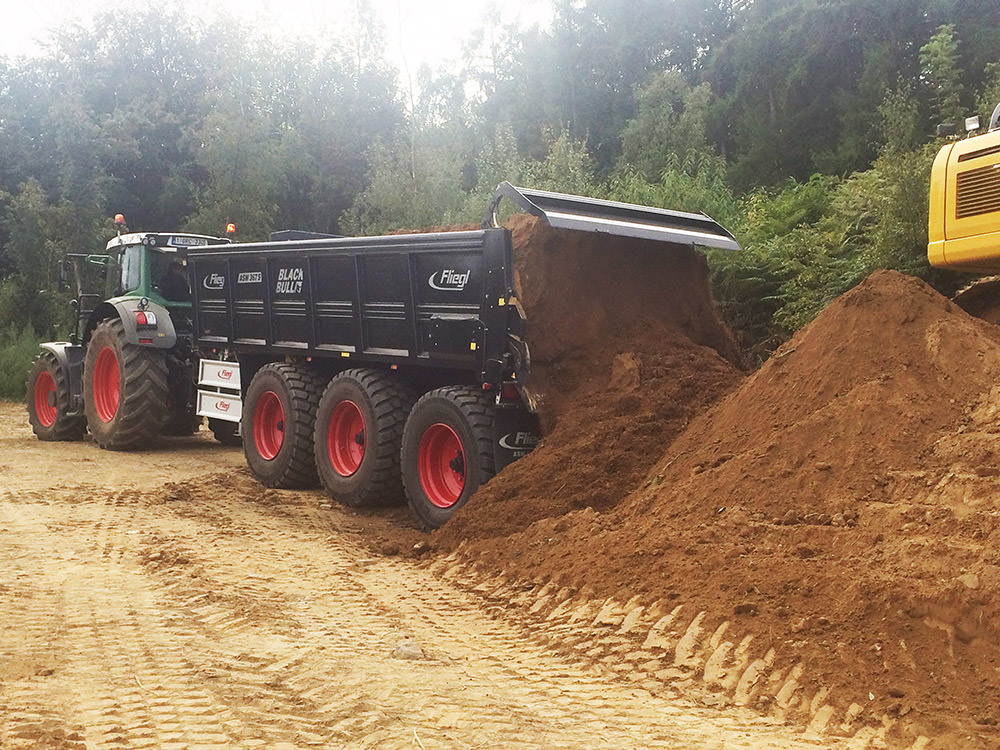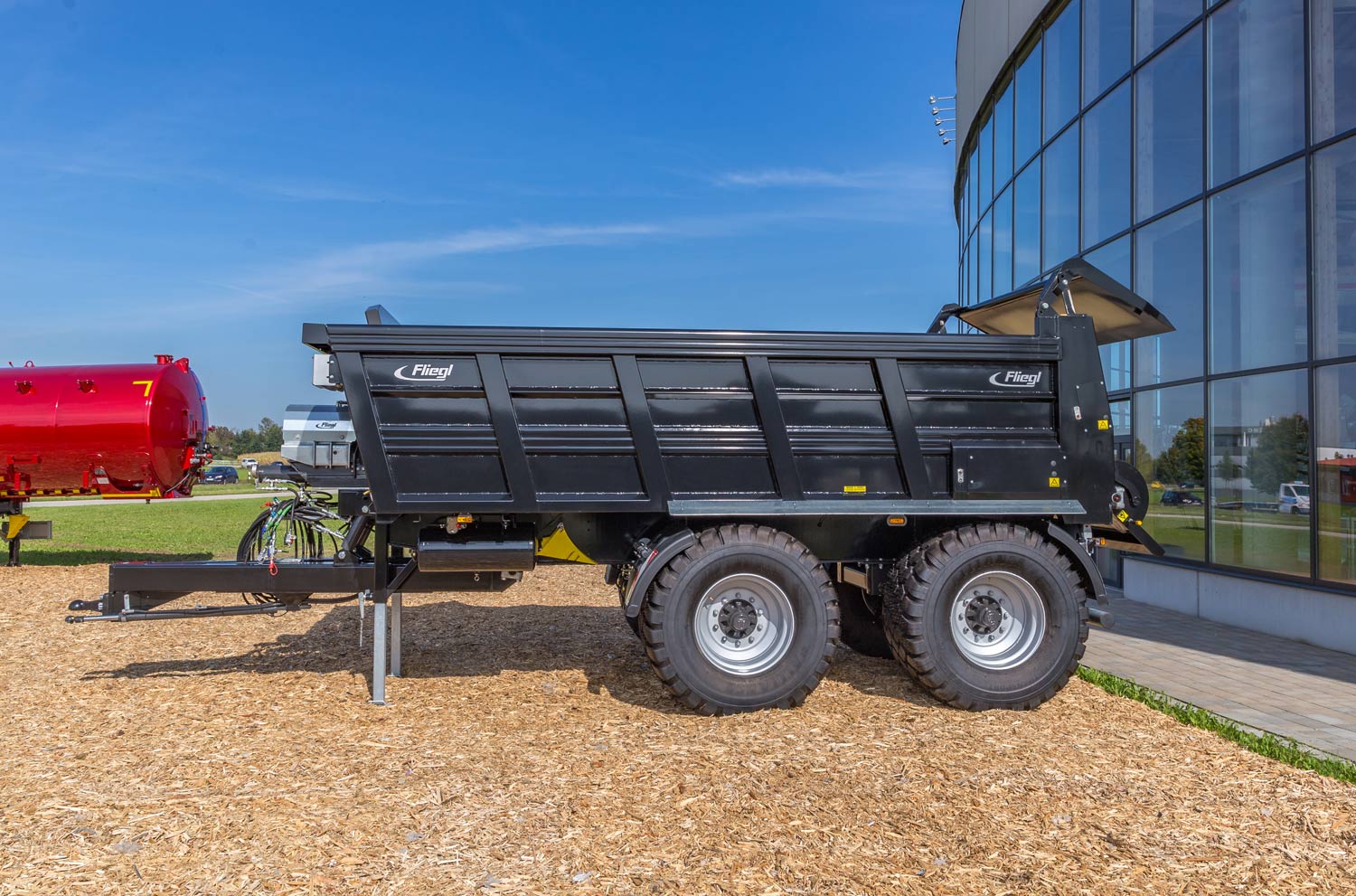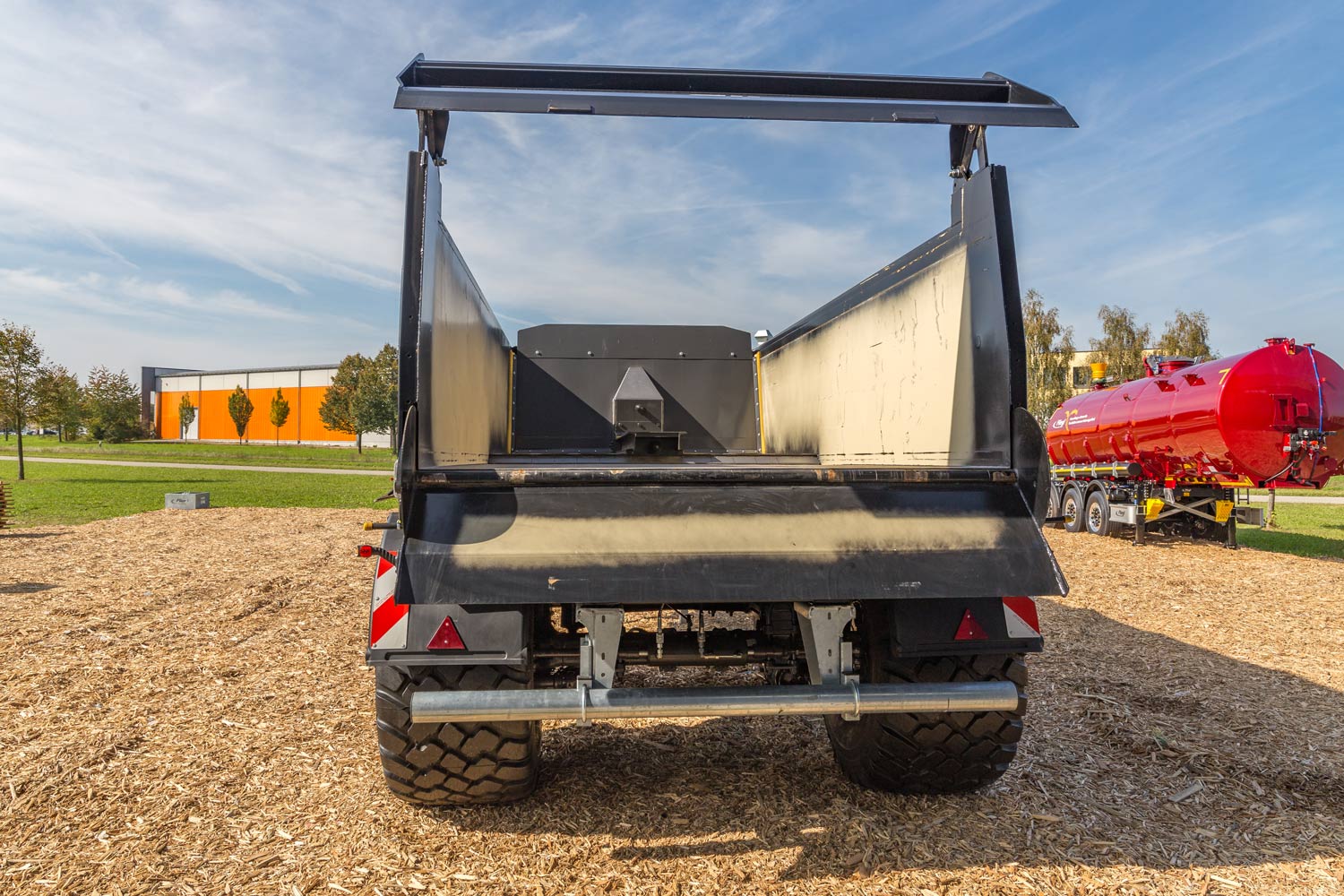ASW 248 BIG RUN

ASW "Stone" heavy-duty push-off trailer with Fliegl push-off technology!
Using the ASW "Stone" heavy-duty push-off trailer pays dividends for companies operating in the road construction and earthmoving sectors. This has been demonstrated in practical tests involving the transport of excavated earth and gravel on airports, road and trail construction, brown coal opencast mining as well as earth wall and embankment work on motorway construction sites.
The tractor/trailer combination with the Fliegl heavy-duty push-off trailer always comes out in top in practical tests with competing transport units.
-
Complete emptying, even of highly viscous material (loam, wet ground and clay etc., including in winter)
-
Safe unloading, even on sloping ground
-
Straightforward push-off in load buildings, tunnels or underground
-
Hydraulically sprung drawbar
-
With hydraulic suspension:
maximum comfort = first-class ride comfort
-
No manual cleaning or scraping of the tipper bridge
-
No knocks and jolts like with rubber blocks
-
Hydraulic height adjustment
-
Very low requirement: only approx. 14/17 l (tandem), approx. 27 l (tridem) consumed oil volume from tank. Therefore, no on-board hydraulics with drive shaft required.
-
No material build-up, which would otherwise reduce the load volume and thus the effective payload over time.
Practical test – transport of excavated earth on the grounds of Berlin Schönefeld Airport
With its robust Hardox steel construction, the Fliegl "ASW Stone" heavy-duty push off trailer is a highly flexible tool for transporting and unloading a wide range of rough and coarse materials such as rock, gravel, excavated earth and sand. The original Fliegl push-off technology combines low wear with rapid operation and offers significant advantages over other unloading systems. Its use offers impressive output rates during transport and unloading and helps to ensure significant cost savings. Among other things, this is due to the system's relatively low net weight owing to its self-supporting structure as well as the low oil and power requirements attributable to the lack of oil- and power-hungry telescopic cylinders.
Practical experience has shown that push-off trailers offer greater performance and economic efficiency than other unloading systems. This was established in a field test of different transport systems used to load, transport and unload excavated earth on the grounds of Berlin Schönefeld Airport. In the test, the following systems
were ranked in order of average load volume:
| Tractor and Fliegl ASW 250 | 15.55 cbm |
| Tractor and dumper | 14.16 cbm |
| Dump truck A | 15.50 cbm |
| Dump truck B | 20.80 cbm |
All vehicles covered the same route, 97.6 km in nine round trips, which partially involved difficult terrain with very loose ground. A standard all-wheel-drive truck could not be used in these difficult conditions. The vehicles were loaded with an excavator equipped with a 2.5 cubic metre bucket.
Under the above conditions, the tractor/trailer combination with the Fliegl ASW 250 push-off trailer took first place with a performance coefficient of 2.24 per cubic metre of load volume. It was followed by dump trucks A and B with performance coefficients of 2.05 and 2.01 respectively. The tractor with dumper came last with a performance coefficient of 1.95. This shows that the tractor/trailer combination with sophisticated Fliegl push-off technology offers greater performance than both the standard dump trucks as well as the tractor and dumper trailer combination.
Field test – gravel transport at Inden coal mine
When it comes to fuel consumption per cubic metre of loaded material, the tractor with dumper comes out on top: It uses 0.65 l/m3 of diesel, followed by the tractor/trailer combination with the push-off trailer, which consumes 0.68 l/m3. Dump truck B uses 0.70 l/m3 while the diesel consumption of dump truck A is 0.87 l/m3.
When examining the profitability of transport measures, the final aspect to consider is the unit cost, that is the total cost including the machine rental as well as personnel and diesel costs per cubic metre of transported materials. These have been calculated at the current rate. In the up-to-date unit cost comparison, the tractor/trailer combination with the Fliegl ASW 250 push-off trailer comes out on top thanks to its performance figures. The unit cost breakdown is as follows:
| Tractor/trailer combination with Fliegl ASW 250 | 1.72 euro/cbm |
| Tractor with dumper | 1.98 euro/cbm |
| Dump truck B | 2.14 euro/cbm |
| Dump truck A | 2.20 euro/cbm |
If, for example, a construction company were to use tractors with the Fliegl push-off trailer for a major project with 6.6 million cubic metres of excavated earth under identical conditions, the cost savings over the other transport options would be significant:
| Savings over dump truck A | 3.168 million euro |
| Savings over dump truck B | 2.772 million euro |
| Savings over tractor with dumper | 1.716 million euro |
The field test involved a direct comparison between the transport unit Fendt Vario 936 (265 kW/360 hp) with the Fliegl "ASW 248 Stone" heavy-duty push off and a truck (301 kW/410 hp) with 8x4 all-wheel drive and special tyres. Both were loaded with a Komatsu PW 220 excavator. The ASW 248 accommodated just over 12 bucket loads of gravel on average, while the all-wheel drive truck was loaded with 11 buckets.
The gravel was transported on varying surfaces, both overlaid with gravel and consisting of loose, soft sand. Neither of the competitors had any trouble on the gravel paths. On the loose, unstable sand, the tractor with the "ASW 248 Stone" pulled away from the all-wheel drive truck thanks to the better traction of the towing vehicle.
The performance data was calculated on the basis of the recorded times, fuel consumption and the number of trips. The times were measured accurately with a stopwatch. The exact fuel consumption was determined for the Fendt Vario, while the relevant figure for the all-wheel drive truck was based on information from the driver.
Field test – gravel transport at Hambach coal mine
The performance and costs per operating hour (Oh) and cubic metre (m3) were calculated. The "ASW 248 Stone" transport unit completed 9 trips while the all-wheel drive truck covered 13. The measured and calculated data for both transport units is provided below:
| ASW 248 Stone | All-wheel drive truck | |
| Journey time (Ø) | 13:58 min | 15:28 min |
| Transported gravel volume (Ø) | 78.00 cbm/Oh | 64.00 cbm/Oh |
| Diesel consumption (Oh) | 14.80 l/Oh | 18.50 l/Oh |
| Diesel consumption (cbm) | 0.189 l/cbm | 0.290 l/cbm |
| Est. total cost (Oh) | 60.00 €/Oh | 63.00 €/Oh |
| Total costs (€/cbm) | 0.77 €/cbm | 0.98 €/cbm |
| Cost saving (€/cbm) | 0.21 €/cbm |
The "ASW 248 Stone" emerges victorious in the comparison by achieving a cost saving of 0.21 euro per cubic metre over its rival. This equates to savings of 210 euro for a transported load of 1000 cubic metres.
The transport unit Fendt Vario 936 with the Fliegl "ASW 248 Stone" heavy-duty push-off trailer was compared with a dump truck (218 kW / 296 hp) in a field test involving the transport of gravel at the opencast mine in Hambach. Both were loaded with around 4 buckets of gravel by a Volvo L150F wheel loader. They transported the loads over challenging surfaces consisting largely of extremely rough terrain with steep slopes and inclines as well as on loose and unstable sandy ground. On these difficult surfaces, both competitors offered good traction, though the dump truck made slower progress on soft and loose ground. On the challenging sloping terrain, the "ASW 248 Stone" impressed with its unwavering stability – largely attributable to the innovative push-off technology – while the dump truck found itself in some precarious situations during tipping.
The performance data was calculated on the basis of the recorded times, fuel consumption and the number of trips. The times were measured accurately with a stopwatch. The exact fuel consumption was determined for the Fendt Vario, while the relevant figure for the dump truck was based on information from the driver. The "ASW 248 Stone" transport unit and the dump truck both completed 4 round trips. The measured and calculated data for both transport units is provided below:
| ASW 248 Stone | Dump truck | |
| Journey time (Ø) | 29:00 min | 32:42 min |
| Transported gravel volume (Ø) | 37.22 cbm/Oh | 33.01 cbm/Oh |
| Diesel consumption (Oh) | 16.20 l/Oh | 25.80 l/Oh |
| Diesel consumption (cbm) | 0.430 l/cbm | 0.910 l/cbm |
| Est. total cost (Oh) | 60.00 €/Oh | 83.00 €/Oh |
| Total costs (€/cbm) | 1.61 €/cbm | 2.51 €/cbm |
| Cost saving (€/cbm) | 0.90 €/cbm |
The "ASW 248 Stone" emerges victorious in the comparison by achieving a cost saving of 0.90 euro per cubic metre over its rival. This equates to savings of no less than 900 euro for a transported load of 1000 cubic metres.
ASW Stone trailer
| Type Type | ASW 248 ASW 248 | Type Type | ASW 252 ASW 252 | ASW 252 ASW 252 | ASW 367 ASW 367 | ASW 367 ASW 367 | |||||||||||||||||
|---|---|---|---|---|---|---|---|---|---|---|---|---|---|---|---|---|---|---|---|---|---|---|---|
| Stone Stone | Black Bull | Black Bull | Black Bull | Black Bull | |||||||||||||||||||
| (Big Run) (Big Run) | Floating Floating | Hydraulic | Air Air | Hydraulic | |||||||||||||||||||
| Capacity, heaped (volumetric) Capacity, heaped (volumetric) | m³ approx. | 14.2 (11.7) 14.2 (11.7) | Capacity, slightly heaped (volumetric) Capacity, slightly (volumetric) | m³ approx. | |||||||||||||||||||
| Total weight acc. to StVZO (depending on equipment) | up to kg | 22,000 | Total weight acc. to StVZO (depending on equipment) | up to kg | 22,000 | 24,000 | 33,000 | 31,000 | |||||||||||||||
| Body length incl. 500 mm high-capacity rear panel | mm | 5,300 | Body length | mm | 5,230 | 5,230 | 6,730 | 6,730 | |||||||||||||||
| Internal body width | mm | 2,380 | Internal body width | mm | 2,370 | 2,370 | 2,370 | 2,370 | |||||||||||||||
| Lateral body height | mm | 1,100 | Lateral body height | mm | 1,150 | 1,150 | 1,150 | 1,150 | |||||||||||||||
| Required/consumed oil volume from tank (oil volume for push-off process) Required/consumed oil volume from tank (oil volume for push-off process) | l approx. | Only 14 (36) Only 14 (36) | Required/consumed oil volume from tank (oil volume for push-off process) Required/consumed oil volume from tank (oil volume for push-off process) | l approx. | Only 17 (56) Only 17 (56) | Only 17 (56) Only 17 (56) | Only 27 (85) Only 27 (85) | Only 27 (85) Only 27 (85) | |||||||||||||||
| No. of brake axles | 2 | No. of brake axles | 2 | 2 | 2 | 2 | |||||||||||||||||
| Axle (brake) | mm | 410x180 | Axle (brake) | mm | 410x180 | 410x180 | 410x180 | 410x180 | |||||||||||||||
| Axle cross section | mm | 150x150 | Axle cross section | mm | 150x150 | 150x150 | 150x150 | 150x150 | |||||||||||||||
| Axle assembly, mechanically adjustable | Standard | Forced steering | / | Standard | Standard | Standard | |||||||||||||||||
| "TITAN plus" axle assembly | Standard | 2nd axle | 1st and 3rd axle 1st and 3rd axle | 1st and 3rd axle 1st and 3rd axle | |||||||||||||||||||
| Floating axle assembly | Optional | Floating assembly / air suspension | Floating standard | / | Air standard | / | |||||||||||||||||
| Tyres 650/55-R26.5* | Standard | Hydraulic suspension | / | Standard | / | Standard | |||||||||||||||||
| Traction bar, hydraulically sprung / height-adjustable | Standard | Tyres 650/55-R26.5 | Standard | Standard | Standard | Standard | |||||||||||||||||
| Automatic load-dependent brake force regulator (ALB) | Standard | Tyres 600/60-R30.5 | / | Optional | Optional | / | |||||||||||||||||
| Max. speed | km/h | 40 | Traction bar, hydraulically sprung / height-adjustable (reinforced V-drawbar) | Standard | Standard | Standard | Standard | ||||||||||||||||
| Automatic load-dependent brake force regulator (ALB) | Standard | Standard | Standard | Standard | |||||||||||||||||||
| Max. speed | km/h | 40 | 40 | 40 | 40 | ||||||||||||||||||





























